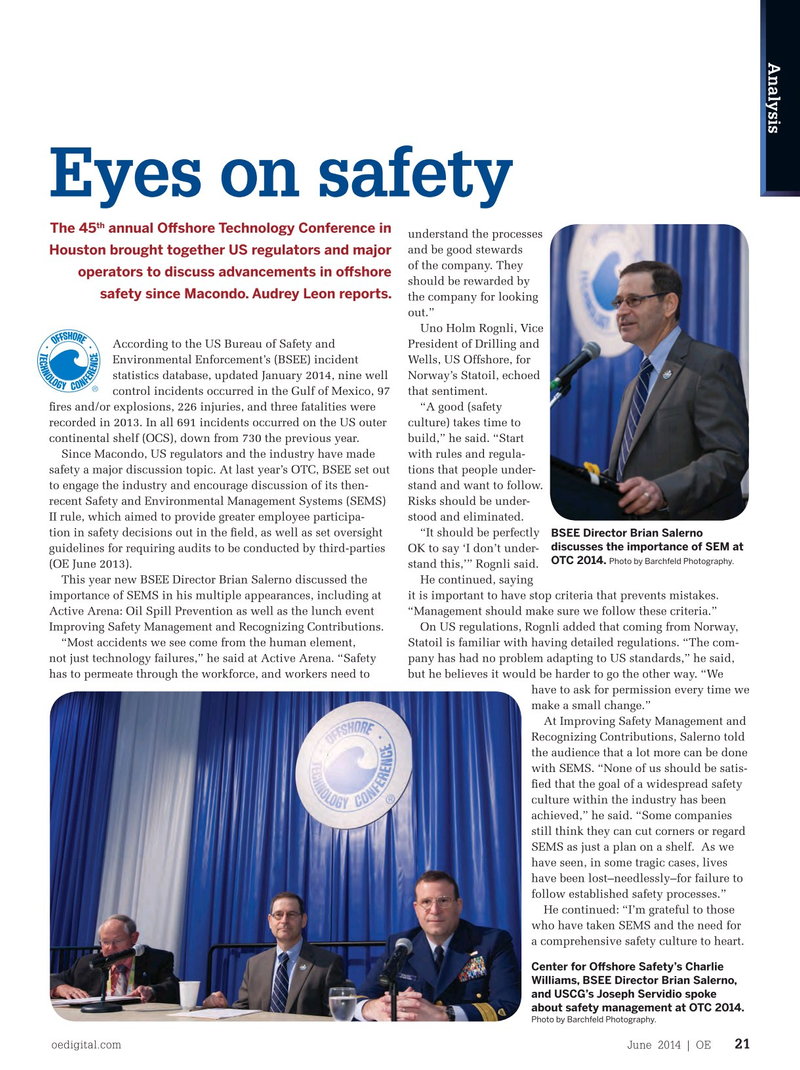
Page 19: of Offshore Engineer Magazine (Jun/Jul 2014)
Read this page in Pdf, Flash or Html5 edition of Jun/Jul 2014 Offshore Engineer Magazine
Analysis
Eyes on safety th
The 45 annual Ofshore Technology Conference in understand the processes and be good stewards
Houston brought together US regulators and major of the company. They operators to discuss advancements in ofshore should be rewarded by safety since Macondo. Audrey Leon reports.
the company for looking out.”
Uno Holm Rognli, Vice
According to the US Bureau of Safety and President of Drilling and
Environmental Enforcement’s (BSEE) incident Wells, US Offshore, for statistics database, updated January 2014, nine well Norway’s Statoil, echoed control incidents occurred in the Gulf of Mexico, 97 that sentiment. fres and/or explosions, 226 injuries, and three fatalities were “A good (safety recorded in 2013. In all 691 incidents occurred on the US outer culture) takes time to continental shelf (OCS), down from 730 the previous year. build,” he said. “Start
Since Macondo, US regulators and the industry have made with rules and regula- safety a major discussion topic. At last year’s OTC, BSEE set out tions that people under- to engage the industry and encourage discussion of its then- stand and want to follow. recent Safety and Environmental Management Systems (SEMS) Risks should be under-
II rule, which aimed to provide greater employee participa- stood and eliminated.
tion in safety decisions out in the feld, as well as set oversight “It should be perfectly
BSEE Director Brian Salerno discusses the importance of SEM at guidelines for requiring audits to be conducted by third-parties OK to say ‘I don’t under-
OTC 2014. Photo by Barchfeld Photography.
(OE June 2013). stand this,’” Rognli said.
This year new BSEE Director Brian Salerno discussed the He continued, saying importance of SEMS in his multiple appearances, including at it is important to have stop criteria that prevents mistakes.
Active Arena: Oil Spill Prevention as well as the lunch event “Management should make sure we follow these criteria.”
Improving Safety Management and Recognizing Contributions. On US regulations, Rognli added that coming from Norway, “Most accidents we see come from the human element, Statoil is familiar with having detailed regulations. “The com- not just technology failures,” he said at Active Arena. “Safety pany has had no problem adapting to US standards,” he said, has to permeate through the workforce, and workers need to but he believes it would be harder to go the other way. “We have to ask for permission every time we make a small change.”
At Improving Safety Management and
Recognizing Contributions, Salerno told the audience that a lot more can be done with SEMS. “None of us should be satis- fed that the goal of a widespread safety culture within the industry has been achieved,” he said. “Some companies still think they can cut corners or regard
SEMS as just a plan on a shelf. As we have seen, in some tragic cases, lives have been lost–needlessly–for failure to follow established safety processes.”
He continued: “I’m grateful to those who have taken SEMS and the need for a comprehensive safety culture to heart.
Center for Ofshore Safety’s Charlie
Williams, BSEE Director Brian Salerno, and USCG’s Joseph Servidio spoke about safety management at OTC 2014.
Photo by Barchfeld Photography.
oedigital.com June 2014 | OE 21 021-OE0614_Analysis.indd 21 5/22/14 9:32 PM

 18
18

 20
20